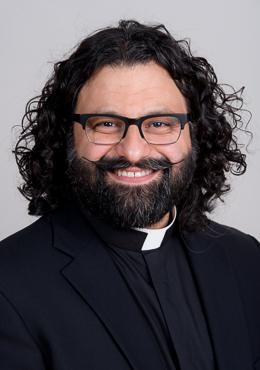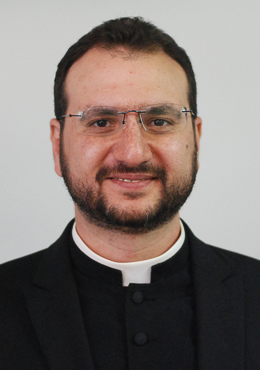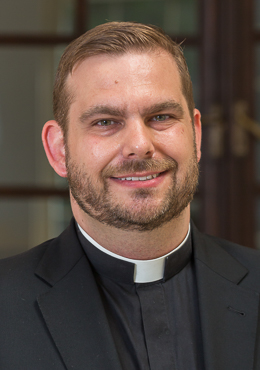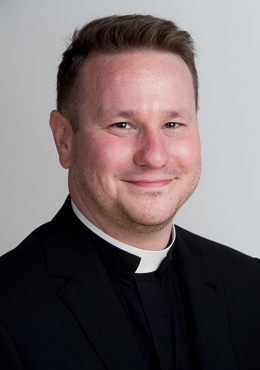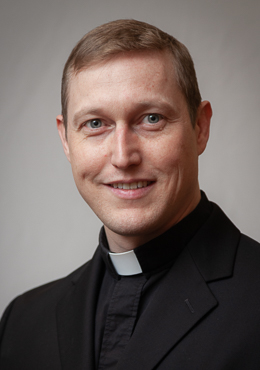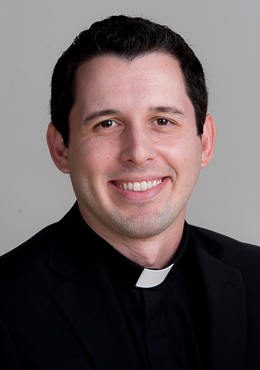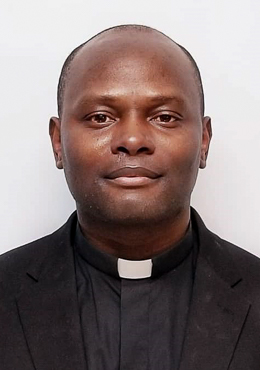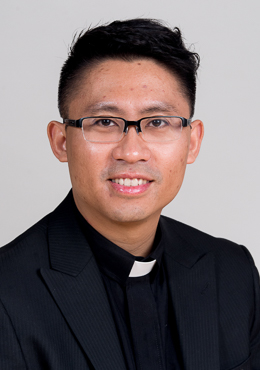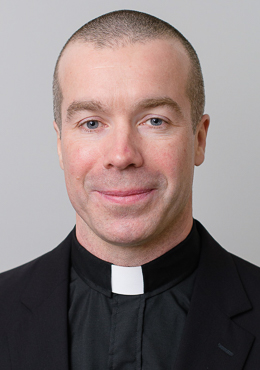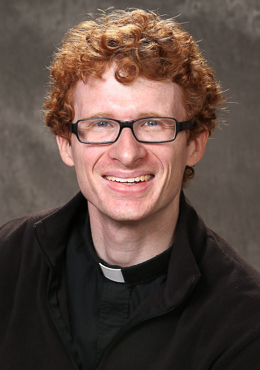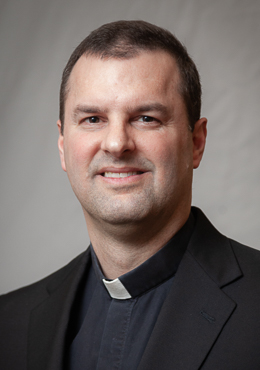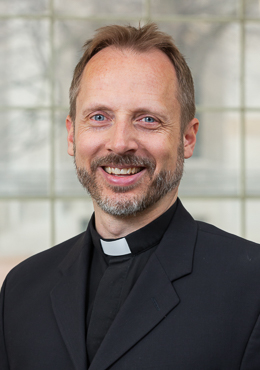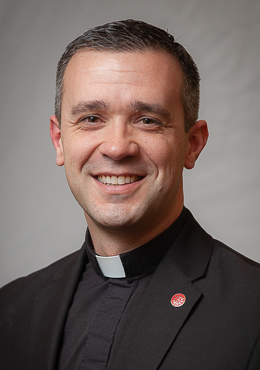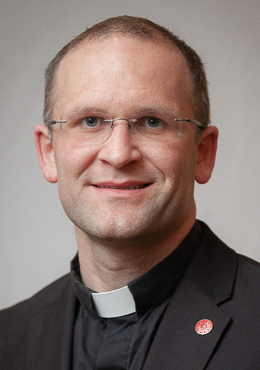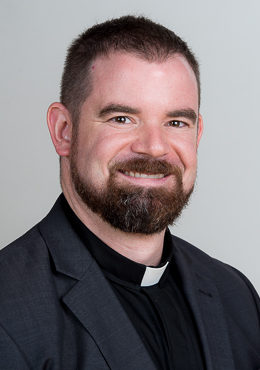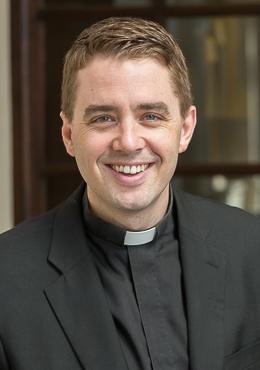
Province: Maryland
Birthday: July 24, 1986
Hometown: Lower Merion, Pennsylvania
Education:
Bachelor’s degree, history, Saint Joseph’s University
Master of Divinity, Jesuit School of Theology of Santa Clara University
Highlights of Jesuit Formation:
Studied Spanish in Bolivia and Costa Rica
Taught American and world history, served as assistant boys’
lacrosse coach and began a summer service learning program (two weeks of team
teaching and field research for students) at Cristo Rey Jesuit High School in Baltimore,
Maryland
Served as a deacon, helped form a youth group and put together bilingual
(English/Spanish) worship at Saint Jarlath’s Parish in Oakland
Post-Ordination:
Will serve this summer at Our Lady of Mount Carmel + Saint Benedicta + Saint Mary of the Assumption in Staten Island, New York. Then, will move to Parras de la Fuente, Mexico and serve at the Jesuit parish of Santa Maria de las Parras through June 2020
Biography:
Vinny Marchionni, SJ, was born in Lower
Merion, Pennsylvania, and attended Saint Aloysius Academy in Bryn Mawr,
Pennsylvania. It was there he received instruction in the faith from the
Sisters, Servants of the Immaculate Heart of Mary and their collaborators. He
then attended Philadelphia’s St. Joseph’s Preparatory School and Saint Joseph’s
University. Vinny discovered his Jesuit vocation during a talk on SJU’s campus
about the school’s Jesuit identity. He credits Jesuits on campus for teaching
him how to pray the examen and to do Ignatian contemplation as part of his
discernment. He entered the Jesuits of the Maryland Province on August 23,
2008, in Syracuse, New York. As a novice, he worked in Catholic schools, in
hospitals and nursing homes, and at a homeless outreach and studied Spanish in
Bolivia. Most importantly, he completed the 30-day Spiritual Exercises of St. Ignatius. Upon professing perpetual vows in 2010, he studied philosophy and
theology at Saint Louis University. In addition to his studies, he continued to
serve the homeless through one of the local Jesuit parishes as well as help
with campus ministry at SLU and engage in vocation promotion. His regency stage
of formation was at Cristo Rey Jesuit High School in Baltimore, Maryland, where
he taught American and world history for three years as well as served as
assistant boys’ lacrosse coach. He moved to Berkeley, California, in 2016 to
finish his theology studies at the Jesuit School of Theology of Santa Clara
University. While in the Bay Area he has also helped at St. Jarlath’s Parish in
Oakland where he helped form a youth group, put together bilingual
(English/Spanish) worship and served as a deacon. Vinny will serve in two
parishes his first year of priesthood. This summer, he will serve at Our Lady
of Mount Carmel + Saint Benedicta + Saint Mary of the Assumption in Staten
Island, New York. Then in September he will move to Parras de la Fuente,
Mexico, and serve at the Jesuit parish of Santa Maria de las Parras through
June 2020. (Maryland Province)

Vinny with students at Cristo Rey Jesuit High School in Baltimore, Maryland.
What is one hobby you’ve cultivated as a Jesuit and why is it important
to you?
I have always loved going to the gym. When I arrived at theology
studies, I wanted to change it up, so I have focused my attention on
powerlifting, which has taught me to integrate my body for a purpose, in this
case to lift a very heavy object. While some might say that the squat is for
legs or the bench is for chest, the reality is that a lifter uses every part of
his body to complete each lift. It is total body integration as my breathing,
my core and my feet provide a foundation for the larger muscle groups to
function. Mental focus and strength improves as I focus not on the weight or
wanting to sculpt any particular part of my body, but simply to stay
disciplined and maintain good form throughout the lift. It is beautiful to see
what a body can do when it is properly attuned and disposed. I see this helping
me in future sacramental ministry — not because chalices are so heavy — in that
a priest uses his body to help the people of God experience God. Through voice
and gesture, priests become vessels and if I can keep the physical and mental
discipline as well as bodily integration I learned while powerlifting, I know
my sacramental ministry will be consoling for God’s people and fulfilling for
me.
How might you explain the Jesuit motto "ad maiorem Dei
gloriam" to someone who’s never heard it before?
The Greater Glory of God is not about doing more than others or
self-help or trying to create the most innovative this or that. It’s not about
going to some far-flung mission or getting a particular degree or becoming an
expert in anything. It’s not a just way of branding Jesuit apostolates. It is
simply asking myself, “What can I do that will make me more intensely keep my
eyes on Jesus in this journey?” Then it is asking God for the grace to choose that
which keeps me focused on Jesus and full of love to serve the people of God.
It’s a very simple equation that can be tricky to solve in the midst of
everyday life. However, it’s the bedrock of our discernment process and the
ways we conceive of and carry on our missions.
What is your favorite book, movie, music, or TV show
you’ve encountered since entering the Society and why do you love it?
For whatever reason I love
tragedies. A traditional tragedy involves a genuinely good character with a
crucial flaw that is exposed in the story and leads to his/her doom. I love
traveling with characters even when it is clear that they will not succeed.
These stories allow me to process my own grief and woe as well as grow in
empathy with people who suffer when I encounter them in ministry.
When I did regency in Baltimore, I decided to watch “The Wire,” an HBO drama set and shot in Baltimore. It is a systematic tragedy that shows honestly good people suffering the longer they stay within the confines of the machines that control their lives on either side of the law. Salvation only comes for those who in some way escape the systems; everyone else is chewed up and suffers. It helped me make sense of my mission in that city, and while its themes of crime, economics, politics, police, education and news could be told of any major city, the fact that I recognized many of the landmarks allowed me to fall more in the love with a city broken by years of pain.
My mission in that city was to teach at the Cristo Rey school there. I taught Baltimore residents and got a chance to know the city simply from being there. I heard my students’ stories about the city and heard their frustration, their desire to leave and their inability to change much around them. These frustrations came to a head after Freddie Gray died in April 2015. I had already seen the city’s tragedy unfold in a fictional drama. Now I was seeing it in my students’ lives and then on national news coverage. Systematic issues portrayed on HBO found new characters in the news. People caught in the machine continued to die in a city with one of the highest per capita murder rates in the country. Police helicopters hovered over high schools the rest of my time there. The city and county cultural gap widened. I grew to love the city deeply because it was at the cross, a locus of tragedy but also a locus of redemption and hope.
I trust more than ever that the Spirit blows by the cross in Baltimore in the students I taught, students with great drive to see their city transformed and to stop the tragedy in its tracks. I liked “The Wire” so much I watched it a second time in regency. Then I watched it again in theology studies and I still check out clips on YouTube. When I watch episodes and clips, I am in awe for how much I love the city and its people.

Vinny lifting weights in the Jesuit community gym.
What do you love about the Society of Jesus?
Living in a religious order, as a
chaste, poor, obedient man, is not easy. But living with some of the most
talented men in the American and global church makes this life joyful.
Community life is what I love most about being a Jesuit because the chance to
pray, work and socialize with my brother Jesuits makes me happy. In theology
studies I have lived with men from almost all the continents and now I can say
I have brothers all over the world. From Croatia to Chile and Uruguay to Benin
and Congo-Kinshasa to India, I have the support of men who know me at my best
and at my worst.
Community life knows no borders or fixed address but instead resides in my heart as I remember my brothers and they remember me. Each time I move into a new Jesuit community, from Baltimore to Bolivia, I have noticed three photos all communities have in a prominent place: one of the pope, one of the Father General and one of the local bishop. When I have seen that, I know I am home in a community in whatever culture or in whatever mission I have received.
What was one particularly meaningful experience you
had during your formation, and why was it meaningful to you?
Last summer I had the chance to
study Spanish in Costa Rica. During that time I became familiar with their
national patroness, Our Lady of the Angels. As the story goes, a figurine of a
Black Madonna and Child miraculously appeared to Juana Perreira, a Mestizo
woman in 1635. They still have the figurine and it is displayed in the basilica
church built next to the site where the Black Madonna appeared. Like Our Lady
of Guadalupe, Our Lady of the Angels was a woman of color speaking to a local
indigenous person. With her I found a sense of solidarity and empathy.
Further visiting the basilica, I sensed the lovely, expressive and at times seemingly desperate faith of the people of God on display. I bumped into field trips of teenagers as well as field trips of nuns. I saw young mothers on their knees holding their children up to “La Negrita” and asking for protection. The most moving moment visiting the basilica was when I took part in the “Romería,” the pilgrimage from San José to the basilica in Cartago. I, along with about 1.5 million of my closest Costa Rican friends, walked the 24 km route uphill and in the rain. Participants were young and old, multigenerational families, couples, friends — a true cross-section of Costa Rican society.
After about five hours of walking we made it to the basilica. There on our knees, we made our way up the aisle and saw La Negrita. I had a strong sense of God saying “focus” as I looked at the Holy Child. This grace has stayed with me and informed my priesthood. It is all very simple for me, that my priesthood is simply: (1) to stay focused on such a compassionate, vulnerable and loving God and then (2) to remember that I am on my knees with everyone else in this world and to speak God’s love to them in any way I can. I will never forget that pilgrimage and the affection in my heart I learned for the people of God.
